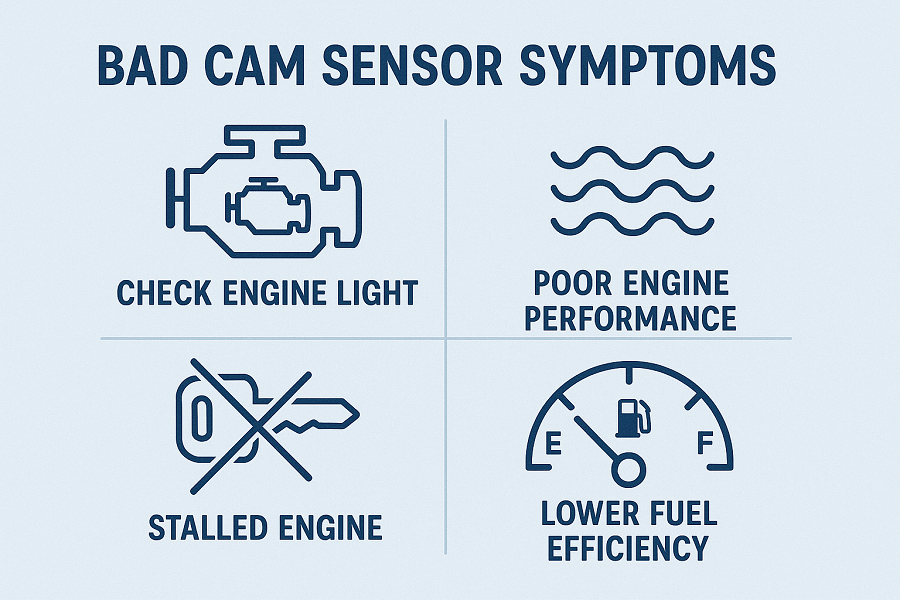1. Introduction
Your engine relies on precise timing to run smoothly, and the camshaft position sensor plays a key role in keeping things in sync. When this small sensor starts to fail, your car may show subtle or serious signs—like rough idling, poor fuel economy, or trouble starting. Ignoring these symptoms can lead to more costly engine issues down the line. In this article, we’ll explore the most common Bad Camshaft Sensor Symptoms, what causes them, and how to fix the problem before it leaves you stranded.
2. What Is a Camshaft Position Sensor?
The camshaft position sensor is a small but important part of your engine. It monitors the position and speed of the camshaft, helping the engine control the timing of fuel injection and spark. This sensor sends signals to the car’s computer, ensuring everything runs smoothly. When the sensor goes bad, your engine may misfire, stall, or hesitate. Understanding how this sensor works is the first step in spotting and fixing camshaft sensor issues.
3. How Does a Bad Camshaft Sensor Affect Your Vehicle?
A faulty camshaft position sensor throws off the timing between the camshaft and crankshaft. This disrupts how fuel and air enter the engine, causing poor performance. Your vehicle may stall at red lights, hesitate when accelerating, or struggle to start. A bad camshaft sensor can also reduce fuel efficiency and increase emissions. Over time, it can lead to engine performance problems that put extra strain on critical components like the catalytic converter and transmission.
4. 10 Common Symptoms of a Bad Camshaft Position Sensor
Here are the top signs of camshaft sensor failure:
- Check engine light – One of the earliest and most common warnings.
- Engine misfire – Poor timing causes the cylinders to fire incorrectly.
- Poor acceleration – Your car may feel sluggish or unresponsive.
- Rough idle – The engine runs unevenly when at a stop.
- Hard starting or no start – Especially when the engine is hot.
- Stalling while driving – Sudden shutdowns, even at highway speeds.
- Transmission shifting problems – Especially in automatic vehicles.
- Reduced fuel economy – The engine burns more fuel than needed.
- Engine surging or hesitation – Inconsistent power delivery.
- Increased exhaust emissions – A failing sensor throws off air/fuel ratios.
5. Hidden or Intermittent Symptoms You Might Miss
Not all camshaft sensor issues are obvious. Some problems come and go, making diagnosis tricky:
- Intermittent power loss – Your car may suddenly lose power and regain it.
- RPM fluctuations – Watch your tachometer bounce without reason.
- Confusion with crankshaft sensor – The symptoms often overlap, making it hard to tell which sensor is to blame without diagnostics.
6. What Causes Camshaft Position Sensors to Fail?
Like any engine component, camshaft sensors wear out over time. Common causes include:
- Oil contamination – Leaks can dirty the sensor and disrupt signals.
- Heat exposure – The engine bay gets hot, and sensors are sensitive.
- Age and vibration – Normal wear and tear eventually take a toll.
- Wiring issues – Frayed or corroded connectors can mimic sensor failure.
- Internal engine problems – A stretched timing chain or damaged camshaft can interfere with readings.

7. How to Diagnose a Faulty Camshaft Position Sensor
You don’t need to be a mechanic to start the diagnosis:
- Use an OBD-II scanner – Look for codes like P0340 or P0341.
- Inspect the sensor wiring – Check for corrosion or loose connectors.
- Use a multimeter – Test the sensor’s voltage and resistance.
- Visual inspection – A damaged or dirty sensor can be spotted without tools.
If you’re unsure, a certified mechanic can run more advanced diagnostics.
8. Can You Drive with a Bad Camshaft Sensor?
Technically, yes—but it’s not a good idea. Driving with a bad camshaft position sensor can lead to more serious problems, like total engine failure or permanent damage to your catalytic converter. You might get away with short trips, but you’re gambling with your engine’s health. If your car stalls or won’t start, the sensor failure has already reached a critical point.
9. How to Fix or Replace a Camshaft Position Sensor
Replacing a camshaft sensor is usually straightforward:
- Disconnect the battery for safety.
- Locate the sensor, typically near the camshaft or cylinder head.
- Unplug the sensor connector.
- Remove the old sensor with a socket or Torx wrench.
- Install the new sensor and reconnect everything.
Make sure to use OEM or high-quality aftermarket parts. Some cars may need the ECU reset after replacement.
10. Cost of Replacing a Camshaft Position Sensor
Here’s what you can expect:
- Parts: $30 to $150 depending on vehicle make.
- Labor: $70 to $200 at most repair shops.
- Total replacement cost: $100 to $350 on average.
DIYers can save on labor, but make sure you’re confident before tackling the job.
11. How to Prevent Camshaft Sensor Failure
Preventive care goes a long way:
- Keep the engine oil clean – Dirty oil can damage the sensor.
- Inspect wiring regularly – Look for signs of wear or corrosion.
- Avoid engine overheating – High heat shortens sensor life.
- Address oil leaks promptly – Oil on the sensor can ruin it.
- Schedule regular maintenance – Especially around 100,000 miles.
12. Related Problems: Crankshaft vs. Camshaft Sensor Issues
These two sensors often get confused:
- The camshaft sensor controls valve timing and ignition.
- The crankshaft sensor controls engine speed and piston position.
- If your car won’t start or misfires, it could be either. Use a scanner to check codes.
Knowing the difference can save time and money on repairs.
13. FAQs
Can a bad camshaft sensor affect shifting?
Yes, especially in automatics. Incorrect timing confuses the transmission computer.
Can I drive without replacing it?
Only for a short time. Eventually, your car may not start at all.
Does a camshaft sensor throw a code?
Yes—common codes include P0340 and P0341.
Will cleaning the sensor fix the issue?
Sometimes, if the issue is just dirt or oil buildup. But most of the time, replacement is needed.
14. Conclusion
A bad camshaft position sensor may start as a minor inconvenience but can quickly become a major issue. From poor acceleration to engine stalling, the symptoms are clear once you know what to look for. With the right knowledge and timely action, you can fix or replace the sensor before it leads to costly repairs. Always pay attention to how your car behaves—your engine is trying to tell you something.


